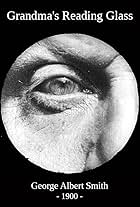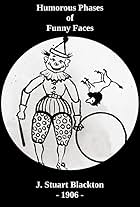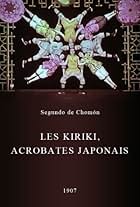IMDb RATING
7.5/10
4.1K
YOUR RATING
Using every known means of transportation, several savants from the Geographic Society undertake a journey through the Alps to the Sun which finishes under the sea.Using every known means of transportation, several savants from the Geographic Society undertake a journey through the Alps to the Sun which finishes under the sea.Using every known means of transportation, several savants from the Geographic Society undertake a journey through the Alps to the Sun which finishes under the sea.
Fernande Albany
- Madame Latrouille
- (uncredited)
Jehanne d'Alcy
- Villager at seaport
- (uncredited)
May de Lavergne
- Nurse in Swiss hospital
- (uncredited)
- Director
- Writers
- All cast & crew
- Production, box office & more at IMDbPro
Storyline
Did you know
- TriviaIncluded in the "Georges Melies: First Wizard of Cinema (1896-1913)" DVD collection, released by Flicker Alley.
- GoofsFor a few seconds, a pole can clearly be seen holding the anthropomorphic sun up.
- Alternate versionsAlso available in a computer colorized version.
- ConnectionsFeatured in Karl May (1974)
Featured review
As many others have noted, "The Impossible Voyage" essentially follows the same adventure structure as Méliès's earlier and most popular film, "Le Voyage dans la lune" (1902). They are, after all, both based on works by Jules Verne and Adolphe Dennery. "The Impossible Voyage", however, is more elaborate and nearly or about twice as long--especially with the additional couple minutes that were available as an extended ending to exhibitors at extra cost (this ending hasn't been included on the Image Entertainment and Kino releases, but has been recently rediscovered and may be released on the upcoming Flicker Alley release). According to historian John Frazer, it cost 37,500 francs ($7,500) to make. "The Impossible Voyage" is also more chaotic, or anarchic--lampooning science and the adventures of science fiction to far greater extent. Whereas in "Le Voyage dans la lune", there was a clear journey executed in a rather concise manner, "The Impossible Voyage", instead, follows a group from The Institute of Incoherent Geography, led by an engineer Mabouloff (which translates as "Scatterbrains" and is played by Méliès), and the journey is, indeed, incoherent at times and certainly not concisely executed. On their trip, they crash their automobile (and there seems to be no reason they were even using it) in the mountains and spend some time in a hospital. They also become frozen inside a refrigerator while on the Sun. Furthermore, a journey to the Sun is obviously absurd in itself, unlike that to the Moon, which wasn't too far-fetched to the imagination even in 1902.
The overall result of this is mixed. On the one hand, it's an ambitious and entertaining film for 1904; on the other hand, the increased emphasis on chaos and satire here over that in "Le Voyage dans la lune" dissolves some of the narrative structure and continuity, especially in how it elongates the picture. Additionally, I can only appreciate the theatrical shot-scene, tableau style of Méliès's narratives in limited amounts. The fallacy of attempting to make cinema an extension of theatre, which was one of Méliès's stated goals, was fully exposed as a travesty with the early feature-length films (for example, "Queen Elizabeth" (Les Amours de la reine Élisabeth) (1912)) that were theatrical dramas rather than fantasies with spectacular theatrical effects. It's also not often acknowledged that filmmaker contemporaries of Méliès were already introducing and experimenting with the cinematic techniques of scene dissection, continuity editing and different camera positions. George Albert Smith, whom Méliès had even had correspondence with, was probably at the forefront of early pioneers in this respect, but also by the mid to late 1900s, the Vitagraph and Pathé companies were already employing crosscutting. Later, Méliès was also a contemporary of D.W. Griffith. Thus, I can't give Méliès a total pass because of his era. Yet, for its time and for what it is, "The Impossible Voyage" remains a somewhat entertaining and amusing film to this day, although I rank it lower than "Le Voyage dans la lune" and even some of his other fantasies, such as "Bluebeard" (1901) and "Kingdom of the Fairies" (1903).
On a further note, at this time--in the era of fairground exhibition of cinema--extra-filmic lecturers, or narrators, would aid audiences in following these new complex narrative films, or provide supplemental information to them. Méliès wrote narration to his story films, such as "The Impossible Voyage", for this purpose. Méliès also offered most of his films in hand-colored versions, for which exhibitors would have to pay an extra price (to give some credit, a team of women headed by a Mrs. Thullier hand colored most of them). Fortunately, and unlike some of his other films, "The Impossible Voyage" is generally available today in a hand-colored version with narration. It's helpful, and it works against some of the other limits of the film. Of the narration, however, it's also another example of the primitiveness of Méliès's films; it may be seen as an admission of their lack of cinematic storytelling and self-contained narration (or, as historian Noël Burch would say, it's "non-closed").
The overall result of this is mixed. On the one hand, it's an ambitious and entertaining film for 1904; on the other hand, the increased emphasis on chaos and satire here over that in "Le Voyage dans la lune" dissolves some of the narrative structure and continuity, especially in how it elongates the picture. Additionally, I can only appreciate the theatrical shot-scene, tableau style of Méliès's narratives in limited amounts. The fallacy of attempting to make cinema an extension of theatre, which was one of Méliès's stated goals, was fully exposed as a travesty with the early feature-length films (for example, "Queen Elizabeth" (Les Amours de la reine Élisabeth) (1912)) that were theatrical dramas rather than fantasies with spectacular theatrical effects. It's also not often acknowledged that filmmaker contemporaries of Méliès were already introducing and experimenting with the cinematic techniques of scene dissection, continuity editing and different camera positions. George Albert Smith, whom Méliès had even had correspondence with, was probably at the forefront of early pioneers in this respect, but also by the mid to late 1900s, the Vitagraph and Pathé companies were already employing crosscutting. Later, Méliès was also a contemporary of D.W. Griffith. Thus, I can't give Méliès a total pass because of his era. Yet, for its time and for what it is, "The Impossible Voyage" remains a somewhat entertaining and amusing film to this day, although I rank it lower than "Le Voyage dans la lune" and even some of his other fantasies, such as "Bluebeard" (1901) and "Kingdom of the Fairies" (1903).
On a further note, at this time--in the era of fairground exhibition of cinema--extra-filmic lecturers, or narrators, would aid audiences in following these new complex narrative films, or provide supplemental information to them. Méliès wrote narration to his story films, such as "The Impossible Voyage", for this purpose. Méliès also offered most of his films in hand-colored versions, for which exhibitors would have to pay an extra price (to give some credit, a team of women headed by a Mrs. Thullier hand colored most of them). Fortunately, and unlike some of his other films, "The Impossible Voyage" is generally available today in a hand-colored version with narration. It's helpful, and it works against some of the other limits of the film. Of the narration, however, it's also another example of the primitiveness of Méliès's films; it may be seen as an admission of their lack of cinematic storytelling and self-contained narration (or, as historian Noël Burch would say, it's "non-closed").
- Cineanalyst
- Feb 1, 2008
- Permalink
Details
- Release date
- Country of origin
- Languages
- Also known as
- The Impossible Voyage
- Filming locations
- Production companies
- See more company credits at IMDbPro
Box office
- Budget
- FRF 37,500 (estimated)
- Runtime24 minutes
- Color
- Sound mix
- Aspect ratio
- 1.33 : 1
Contribute to this page
Suggest an edit or add missing content





















